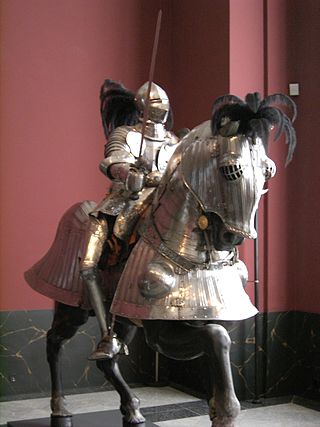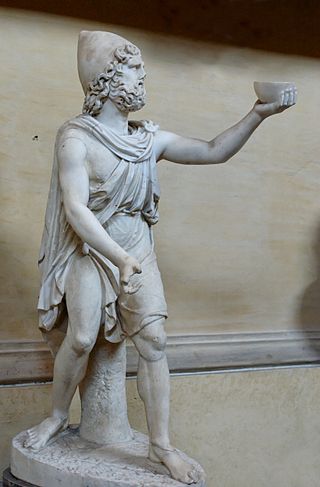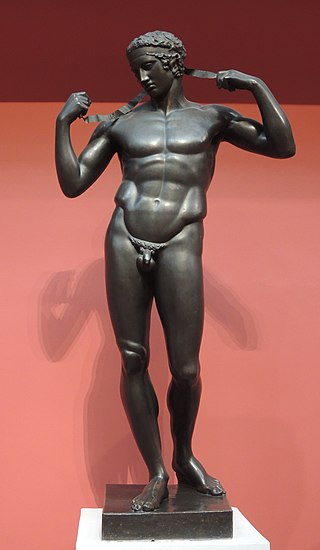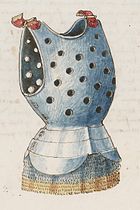
Armour or armor is a covering used to protect an object, individual, or vehicle from physical injury or damage, especially direct contact weapons or projectiles during combat, or from a potentially dangerous environment or activity. Personal armour is used to protect soldiers and war animals. Vehicle armour is used on warships, armoured fighting vehicles, and some combat aircraft, mostly ground attack aircraft.

Chain mail is a type of armour consisting of small metal rings linked together in a pattern to form a mesh. It was in common military use between the 3rd century BC and the 16th century AD in Europe, while it continued to be used in Asia, Africa, and the Middle East as late as the 17th century. A coat of this armour is often called a hauberk or sometimes a byrnie.

A gambeson is a padded defensive jacket, worn as armour separately, or combined with mail or plate armour. Gambesons were produced with a sewing technique called quilting that produced a padded cloth. They were usually constructed of linen or wool; the stuffing varied, and could be, for example, scrap cloth or horse hair.

A cuirass is a piece of armour that covers the torso, formed of one or more pieces of metal or other rigid material. The word probably originates from the original material, leather, from the French cuirace and Latin word coriacea. The use of the term "cuirass" generally refers to both the breastplate and the backplate pieces; whereas a breastplate only protects the front, a cuirass protects both the front and the back of the wearer.

A cataphract was a form of armoured heavy cavalry that originated in Persia and was fielded in ancient warfare throughout Eurasia and Northern Africa.

Plate armour is a historical type of personal body armour made from bronze, iron, or steel plates, culminating in the iconic suit of armour entirely encasing the wearer. Full plate steel armour developed in Europe during the Late Middle Ages, especially in the context of the Hundred Years' War, from the coat of plates worn over mail suits during the 14th century, a century famous for the Transitional armour, in that plate gradually replaced chain mail.

A greave or jambeau is a piece of armor that protects the leg.

The magister equitum, in English Master of the Horse or Master of the Cavalry, was a Roman magistrate appointed as lieutenant to a dictator. His nominal function was to serve as commander of the Roman cavalry in time of war, but just as a dictator could be nominated to respond to other crises, so the magister equitum could operate independently of the cavalry; like the dictator, the appointment of a magister equitum served both military and political purposes.

Chinese armour was predominantly lamellar from the Warring States period onward, prior to which animal parts such as rhinoceros hide, rawhide, and turtle shells were used for protection. Lamellar armour was supplemented by scale armour since the Warring States period or earlier. Partial plate armour was popular from the Eastern and Southern dynasties (420–589), and mail and mountain pattern armour from the Tang dynasty (618–907). Chain mail had been known since the Han dynasty, but did not see widespread production or battlefield use, and may have seen as "exotic foreign armor" used as a display of wealth for wealthier officers and soldiers. During the Ming dynasty (1368–1644), brigandine began to supplant lamellar armour and was used to a great degree into the Qing dynasty (1644–1912). By the 19th century most Qing armour, which was of the brigandine type, were purely ceremonial, having kept the outer studs for aesthetic purposes, and omitted the protective metal plates.

Barding is body armour for war horses. The practice of armoring horses was first extensively developed in antiquity in the eastern kingdoms of Parthia and Pahlava. After the conquests of Alexander the Great it likely made its way into European military practices via the Seleucid Empire and later Byzantine Empire. Though its historical roots lie in antiquity in the regions of what was once the Persian Empire, barded horses have become a symbol of the late European Middle Ages chivalry and the era of knights.
The celeres were the bodyguard of the kings of Rome and the earliest cavalry unit in the Roman military. Traditionally established by Romulus, the legendary founder and first King of Rome, the celeres comprised three hundred men, ten chosen by each of the curiae. The celeres were the strongest and bravest warriors among the early Roman nobility, and were the bravest and most loyal soldiers in the army. The celeres may also have originated in the fourth century BC when the Romans adopted cavalry from the Samnites. The name of celeres was generally believed to have arisen from their celeritas, or swiftness, but Valerius Antias maintained that their first commander was named "Celer", perhaps the same Celer mentioned by Ovid as the foreman of the first fortification built around the Palatine Hill; it was he, rather than Romulus himself, who slew Remus after he overleapt the wall. According to some accounts they were infantry; while according to others they included both or were only cavalry.

Chausses were a Medieval term for leggings, which was also used for leg armour; routinely made of mail and referred to as mail chausses, or demi-chausses if they only cover the front half of the leg. They generally extended well above the knee, covering most of the leg. Mail chausses were the standard type of metal leg armour in Europe from the 9th to the early 14th centuries CE. Chausses offered flexible protection that was effective against most hand-powered weapons, but was gradually supplemented and then replaced with the development of iron plate armor for the legs in the second half of the 13th to first half of the 14th century.

Heavy cavalry was a class of cavalry intended to deliver a battlefield charge and also to act as a tactical reserve; they are also often termed shock cavalry. Although their equipment differed greatly depending on the region and historical period, heavy cavalry were generally mounted on large powerful warhorses, wore body armor, and armed with either lances, swords, maces, flails (disputed), battle axes, or war hammers; their mounts may also have been protected by barding. They were distinct from light cavalry, who were intended for raiding, reconnaissance, screening, skirmishing, patrolling, and tactical communications.

A galea was a Roman soldier's metal helmet, most famously worn by the heavy infantry of the legions. Some gladiators, specifically murmillo (myrmillo), also wore bronze galeae with face masks and decorations, often a fish on its crest. While details varied over time, all Roman galeas from the Republic era through the Principate featured the same basic design - a bowl to protect the skull, a neck guard, a deflector band to protect the forehead and cheek plates to protect the face. The exact form, type of metal, and design of the helmet varied over time, between differing unit types, and also between individual examples – pre-industrial production was by hand – so it is not certain to what degree there was any standardization even under the Roman Empire.

The first evidence of horses in warfare dates from Eurasia between 4000 and 3000 BC. A Sumerian illustration of warfare from 2500 BC depicts some type of equine pulling wagons. By 1600 BC, improved harness and chariot designs made chariot warfare common throughout the Ancient Near East, and the earliest written training manual for war horses was a guide for training chariot horses written about 1350 BC. As formal cavalry tactics replaced the chariot, so did new training methods, and by 360 BC, the Greek cavalry officer Xenophon had written an extensive treatise on horsemanship. The effectiveness of horses in battle was also revolutionized by improvements in technology, such as the invention of the saddle, the stirrup, and the horse collar.

The exomis was a Greek tunic used by the workers and the light infantry. The tunic largely replaced the older chitoniskos as the main tunic of the hoplites during the later 5th century BC. It was made of two rectangles of linen, which were stitched together from the sides to form a cylinder, leaving enough space at the top for the arms. An opening at the top was also left for the head. The cylinder was gathered up at the waist with a cloth belt using a reef knot, which made the cloth fall down over the belt, hiding it from view. To allow freedom of movement to the right arm, the seam at the right shoulder was taken apart, and the right hand was passed through the head opening.

Clothing in ancient Greece refers to clothing starting from the Aegean bronze age to the Hellenistic period. Clothing in ancient Greece included a wide variety of styles but primarily consisted of the chiton, peplos, himation, and chlamys. Ancient Greek civilians typically wore two pieces of clothing draped about the body: an undergarment and a cloak. The people of ancient Greece had many factors that determined what they wore and when they wore it.
Aeinautae were magistrates at Miletus around 600 BC, consisting of the chief men in the state, who obtained the supreme power on the deposition of the tyrants, Thoas and Damasenor. Whenever they wished to deliberate on important matters, they embarked on board ship, put out at a distance from land, and did not return to shore until they had transacted their business.

Laminar armour is an armour made from horizontal overlapping rows or bands of, usually small, solid armour plates called lames, as opposed to lamellar armour, which is made from individual armour scales laced together to form a solid-looking strip of armour. Prominent examples of such armour are lorica segmentata of Ancient Rome and certain versions of samurai armour.

A fillet is a type of headgear. It was originally worn in classical antiquity, especially in cultures of the Mediterranean, Levant and Persia, including Hellenic culture.



















